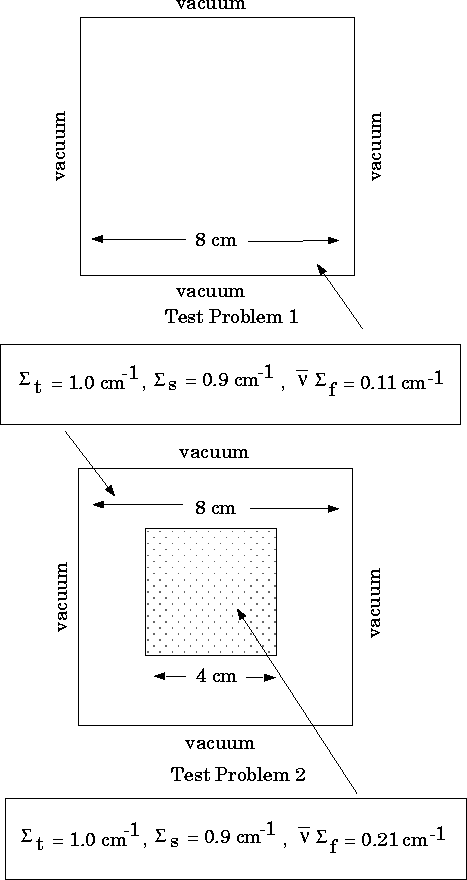


Next: Cycle Versus Cumulative Fission
Up: Numerical Results
Previous: Numerical Results I
In this section we provide results for two dimensional XY geometry cases in one
and two energy groups. Test problems 1 and 2 are for one energy group cases.
Configurations for problems 1 and 2 are specified in figure 2.9.
The first test problem is a 8 cm by 8 cm square region with homogeneous
cross sections of  =1.0 cm-1,
=1.0 cm-1,  = 0.11 cm-1,
and
= 0.11 cm-1,
and
 = 0.9 cm-1; and with vacuum boundary conditions on all sides.
The second test problem is an 8 cm by 8 cm square region with an interior
4 cm by 4 cm square region and vacuum boundary conditions on all
sides. The inner square region has cross sections
of
= 0.9 cm-1; and with vacuum boundary conditions on all sides.
The second test problem is an 8 cm by 8 cm square region with an interior
4 cm by 4 cm square region and vacuum boundary conditions on all
sides. The inner square region has cross sections
of
 =1.0 cm-1,
=1.0 cm-1,  = 0.21 cm-1, and
= 0.21 cm-1, and
 = 0.9 cm-1, and the rest of the system has cross sections of
= 0.9 cm-1, and the rest of the system has cross sections of
 =1.0 cm-1,
=1.0 cm-1,
 = 0.11 cm-1, and
= 0.11 cm-1, and
 = 0.9 cm-1. Test problems 1 and 2 were simulated for 120
active
batches, 40 inactive batches and with 4000 neutrons per batch. Test problem 3
is a homogeneous square region with vacuum boundary conditions on all
sides and two energy groups. Cross sections for test
problem 3 and the configuration is
shown in figure 2.10. Test problem 3 was simulated with 120 active
batches, 40 inactive batches and 2500 neutrons per batch. Results for the
two dimensional problems are shown in table 2.3.
The reference TWODANT results are for
S16 quadrature sets and with inner and outer iteration convergence
criteria of 10-12.
= 0.9 cm-1. Test problems 1 and 2 were simulated for 120
active
batches, 40 inactive batches and with 4000 neutrons per batch. Test problem 3
is a homogeneous square region with vacuum boundary conditions on all
sides and two energy groups. Cross sections for test
problem 3 and the configuration is
shown in figure 2.10. Test problem 3 was simulated with 120 active
batches, 40 inactive batches and 2500 neutrons per batch. Results for the
two dimensional problems are shown in table 2.3.
The reference TWODANT results are for
S16 quadrature sets and with inner and outer iteration convergence
criteria of 10-12.
Table:
Results for Two-Dimensional Problems.
| 1|cProblem |
1|c|TWODANT |
1|c|Source iteration |
1c|Fission matrix |
| Test Problem 1 |
0.640792 |
0.64089  .73E-3 .73E-3 |
0.64130  .83E-3 .83E-3 |
| Test Problem 2 |
1.004494 |
1.00502  .89E-3 .89E-3 |
1.00609  .82E-3 .82E-3 |
| Test Problem 3 |
1.489619 |
1.4897  .17E-2 .17E-2 |
1.4880  .20E-2 .20E-2 |
Figure:
Configuration of Two-Dimensional One Energy Group Problems.
 |
Figure:
Configuration of Two-Dimensional Two Energy Group Problem.
 |



Next: Cycle Versus Cumulative Fission
Up: Numerical Results
Previous: Numerical Results I
Amitava Majumdar
9/20/1999